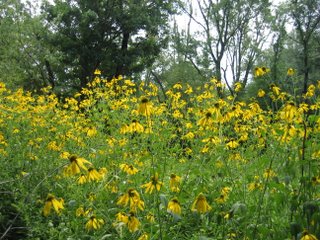 This pond is part of a hand-dug creekbed in a Princeton backyard. During heavy rains, runoff enters the creekbed from upstream neighbors’ yards. The runoff fills a series of mini-ponds and channels of varying depths. Most of the mini-ponds hold water for only a day or two after a rain, while others are deeper and have plastic liners in the bottom that hold water throughout the summer, providing habitat for mosquito-eating fish and various aquatic insects. The series of mini-ponds serve to hold back some of the runoff, which in turn feeds the many floodplain plant species planted in and around the ponds.
This pond is part of a hand-dug creekbed in a Princeton backyard. During heavy rains, runoff enters the creekbed from upstream neighbors’ yards. The runoff fills a series of mini-ponds and channels of varying depths. Most of the mini-ponds hold water for only a day or two after a rain, while others are deeper and have plastic liners in the bottom that hold water throughout the summer, providing habitat for mosquito-eating fish and various aquatic insects. The series of mini-ponds serve to hold back some of the runoff, which in turn feeds the many floodplain plant species planted in and around the ponds.1st Photo: Testing for depth
2nd Photo: Plastic liner and field stones added
3rd Photo: A rain brings water—the pond is now home to water boatmen, water striders, goldfish and wild rice.










